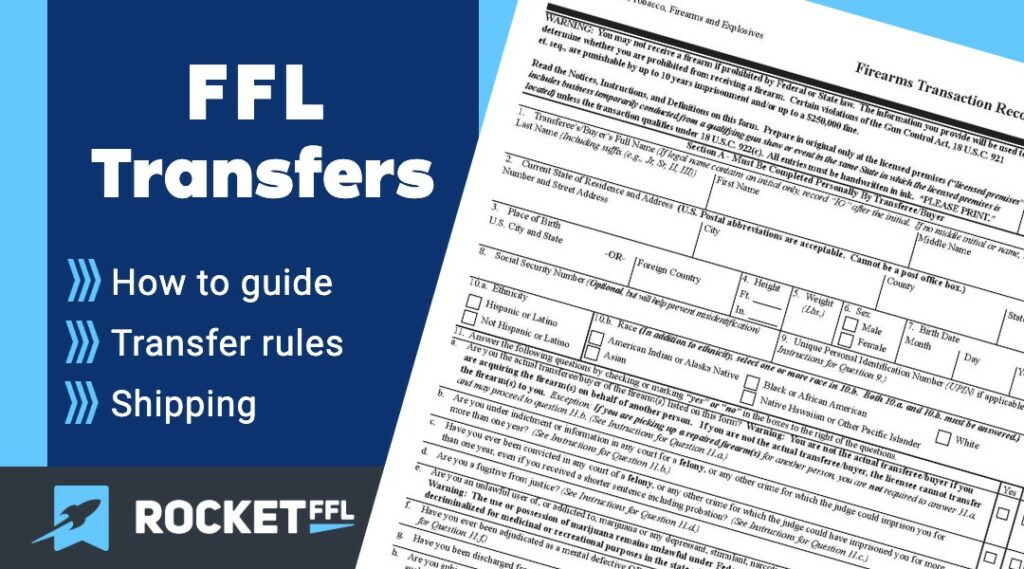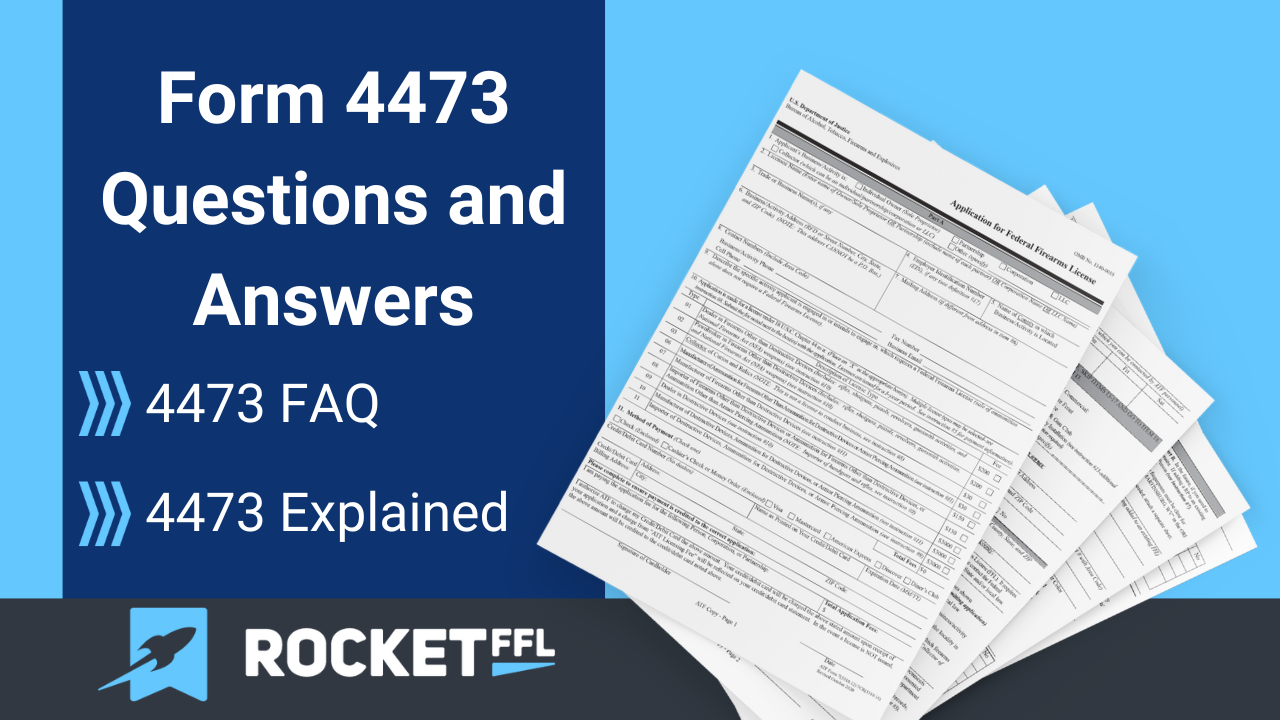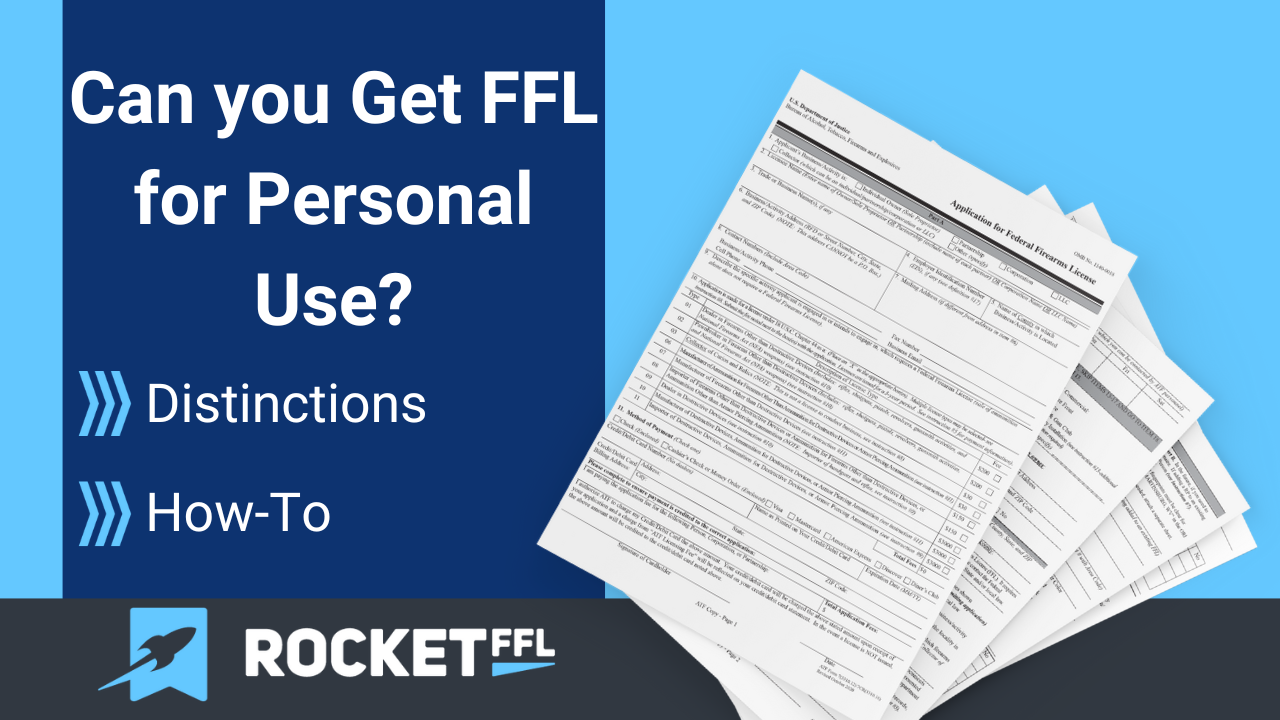There a different types of FFL to choose from. Make sure you understand which FFL type is best for you.

FFL Transfer – How to Transfer a Firearm [2025]
Have you ever tried to send or receive a firearm but weren’t sure how to do it?
Maybe you just bought a firearm online, or you need to ship a gun, and you’re wondering how to transfer it. You might have looked into transferring the gun and you learned that transfers the gun through an FFL can involve navigating many rules and requirements around firearm transfer laws and shipping.
Worry not! Conducting an FFL transfer is easy…. once you know the firearm transfer rules, you’ll be set.
In this article you’ll learn:
FFL Transfers
A firearm transfer, simply speaking, is the change in possession of a firearm from an FFL to another FFL or a person/customer (non-FFL). The person or entity receiving the gun is the transferee.
Technically, any changing of possession of any item is transferring the item, however, the term “transfer,” when used with firearms, almost always means processing the gun through a licensed FFL dealer to a transferee as part of a firearm transaction.
Since the Gun Control Act of 1968 (GCA), firearms that travel interstate (across state lines) must be transferred using a Federal Firearms Licensee (FFL). This is true even if the purchaser has a handgun or firearm permit. This means that firearm transactions (gift, loan, sale, etc.) that happen within the same state don’t require an FFL.
NFA Transfers
NFA items or NFA Firearms, like silencers, short barreled rifles, etc. need to be transferred to an FFL that is also an SOT. Despite a lot of people using the term, there is really no such thing as a Class 3 License but rather an FFL dealer (usually a type 1 FFL) with a Class 3 SOT who will conduct the NFA transfer for the NFA item
NOTE: This is only under federal law – your state may require that all transactions go through an FFL.
So, if you want to loan/gift/sell a firearm to your friend while you are both residents of the same state (and while you’re both in that state), you don’t need to use an FFL under federal law. This is true even if you’re shipping the firearm within the same state! However, see our guide on shipping firearms to see how it can still be problematic.
| In-State | Out-of-state | |
|---|---|---|
| Personally-owned firearm | FFL transfer NOT required* | FFL transfer |
| FFL-owned firearm | FFL transfer | FFL transfer |
*no requirement under FEDERAL law – your state may require all transfers to go through an FFL
When an FFL is used to transfer a firearm, the FFL will acquire (receive) the firearm onto the FFL’s records from an individual (seller) or another FFL (manufacturer or another dealer). Then, the FFL will dispose (give) the firearm to another FFL or to an individual. That entire transaction is a “firearm transfer.”
There’s a bit of paperwork and rules to follow. We’ll cover those, and details on how to find an ffl and ship a gun, after we walk through each step of the FFL Transfer process.
FFL Transfer Process
When you purchase a firearm from an FFL dealer, you will need to have the firearm transferred to you.
If you are not an FFL holder (i.e. you don’t have your own FFL), then you, as the buyer, will need to go to the FFL dealer’s licensed premises to fill out an ATF Form 4473 (and other required paperwork in some states) and satisfy the background check requirements (typically a NICS background check).
The exception to this is you may have the gun (and any additional firearm you purchase) transferred to you at another location as long as it is a “qualifying event” like a gunshow.
As the buyer, you may have to rely on the dealer to know whether the location/event is legitimate.
The place of purchase is not necessarily an issue like the place of transfer is. For example, it is perfectly legal to purchase the gun online as long as it is shipped to an ffl dealer where you go to have it transferred to you.
The FFL transfer process below assumes that you don’t have your own FFL. If you already have your own FFL, then the gun can just be shipped straight to you or straight from you to the other FFL.
Buying a Firearm – Transfer Process
Here are the steps to transferring a firearm as a buyer.
Step 1 – Find a local FFL
Whether you want to buy a gun in-person or online, you are going to need to find a local gun dealer.
If you’re buying in-person, you’ll be able to purchase or order in their store. If you’re buying online (or having it shipped from another FFL), you need to make sure that the FFL is willing to conduct the transfer.
Also, if you’re having the gun sent to the FFL dealer, you need to see if they have any special rules to follow (transfer form to fill out) and what their transfer fee is. It’s a good idea to let them know what to expect if you already know what you’ll be transferring.
If you need help finding a local FFL, we cover that below.
Step 2 – Purchase the Firearm
Before a transfer can take place, you must purchase the firearm. You can either do this in the gun store or online.
If you purchase the item online, you’re going to need to ship it to the ffl dealer you’ve found.
Step 3 – Ship the Firearm (optional)
If you purchased the gun online, or in a gun store other than where you want the firearm transferred to you, you are going to need to ship the firearm to the dealer where you want to transfer the gun.
We cover how to ship firearms below.
If the FFL you selected has a special form or process, be sure to follow it. It’s also a good idea to make sure the gun has your name and number in the package so that they can call you when the shipment arrives.
Step 4 – Transfer the Firearm
When you are on-site at the dealer’s location (or at a gun show), you start the transfer process by filling out the customer portion of the ATF Form 4473.
Take your time and answer honestly!
Common mistakes are including “USA” as the country instead of your county (e.g. Maricopa or Davidson) as required for your address and/or failing to answer all of the yes/no questions.
Once you have completed the form, you will hand the form and your government issued photo ID (don’t forget this) to the gun store employee and they’ll complete their portion of the form and run the NICS background check (unless you qualify for an exemption).
Once approved, they will give you the gun and it’s yours!
Transfer complete. 🙂
Selling a Firearm – Transfer Process
Here are the steps to transferring a firearm as a seller.
Step 1 – Sell the Firearm
The first step, obviously, is to sell the firearm.
If you sell the firearm online (like on gunbroker, for example), make sure you’ve received payment for the firearm before continuing!
Step 2 – Gather Recipient FFL details
You will need to obtain a copy of the FFL license for the destination for the firearm.
As you can see above, the buyer will need to select an FFL that will transfer the gun to them in-person (unless they are already an FFL themselves).
You should use the ATF FFL eZ Check system to confirm the validity of the FFL and address. There is a scam where they send a fake copy to get you to send a gun to a non-ffl – do not fall for this! You may only legally ship a firearm across state lines to a valid FFL.
Step 3 – Ship the Firearm
Package the firearm and include a copy of your driver’s license so that the receiving FFL can properly record where the firearm came from.
For more information on shipping firearms, see below.
Firearm Transfer Rules
The FFL needs to know where the firearm is coming from to properly log it into the FFL’s records. The ATF requires that FFLs maintain a book with all acquisitions and dispositions in a book called the, you guessed it, Acquisition and Disposition Book (A&D).
If you are an individual sending a firearm to an FFL to be transferred, then you should include a copy of your driver’s license in with the firearm so that the FFL can record your name and address. You may not like it, but it’s a requirement that the FFL knows this information.
You should also contact the FFL prior to sending the firearm. After all, the FFL will need to know what to do with the firearm once they receive it. Often, FFLs will just ask you to write the name and contact information of who it is supposed to go to but sometimes they’ll have a form for you to print and fill-in.
If the FFL is transferring the firearm to an individual (either the person buying your gun or you if the transfer is for your gun), then a ATF Form 4473 and NICS background check (with some exceptions) must be completed. This form is the paperwork you fill out whenever you buy a gun from an FFL – it includes your information and answers to questions confirming that you aren’t a prohibited person.
For long-guns (rifles and shotguns), the FFL can transfer the firearm to a resident of any state as long as it’s legal in both states. Handguns, however, can only be transferred to residents of the state where the FFL is located.
Because you can only ship a firearm across state lines to an FFL, you should ALWAYS get a copy of the recipient FFL before you ship the firearm! Once you get a copy, I highly recommend that you use the ATF’s FFL E-Z Check system (we explain the EZ Check System here) It’s not a requirement but it ensures that you didn’t get a fraudulent copy, a fake address, or a surrendered FFL (after it was copied).
I’m obviously biased, but this is one of the reasons I recommend getting your own FFL (even from your home). With an FFL, guns can be shipped straight to you – no transfer through another FFL needed! And if you’d like to get NFA firearms, you’ll want to be an SOT, and not get a “Class 3 License.”
Finding an FFL for a Transfer
How you do this will depend on whether you are the person shipping/giving-up the firearm or the person receiving it.
If you’re making the firearm shipment to someone else, you should have them pick the FFL they want to use and have that FFL send you instructions and a copy of their FFL before shipment.
If you’re receiving the firearm, find a nearby FFL that you like working with and let them know that you’re expecting a transfer – include the description of the firearm and the sender’s information so that they can call you when your firearm arrives.
Here’s a slick resource for finding an FFL: FFLGunDealers.net
Some dealers will have a transfer form that you can fill out to make the process easier for both of you. The transfer form will usually have the serial number of the transferred firearm, the ffl information for the shipping ffl, and your personal details.
It will also typically list their transfer policy. This might include how long the firearm can wait for you before they might charge you a storage fee.
FFL Transfer Fee
Your local FFL (the receiving FFL) is likely to charge an FFL Transfer fee to cover their time and any costs in that state for the NICS background check.
FFL Transfers fees depend on your local gun dealer. Transfer fees for FFLs typically range from $20 to $75.
You should ALWAYS ask your FFL what their transfer fees are before you pick that FFL.
As it is a service, there should not be any sales tax on the invoice for the firearm transaction.
Shipping Firearms
Shipping firearms can be tricky. It is perfectly legal for individuals to ship any firearms through FedEx or UPS but you can only ship a long gun (no handguns) through the USPS unless you have a federal firearms license.
However, FedEx and UPS rules state that you must have a valid FFL License holder involved in the transaction (which means they’ll need to see the copy – don’t tape your box up just yet!) for a firearm shipment. And, it is hit-or-miss on which UPS and FedEx locations know their own rules on whether a firearm can be shipped by an individual. Be prepared for some weird looks.
If you’re an FFL (you have your own federal firearm license) it’s a LOT easier. You can have a shipping account and it raises a lot less questions. Also, as an FFL I walk right into a Post Office (despite the “no guns” signs) to ship firearms (including a pistol or revolver) because I’m an FFL. If you’re interested in becoming an FFL, we offer a step-by-step course on getting an FFL and another for becoming an SOT.
Within the shipment, include all required paperwork like a copy of any needed FFL or transfer forms. If you’re a non-FFL, you’ll want to include a copy of your driver’s license so that the receiving FFL can enter in their FFL records who the gun came from.
An easy way to ship a firearm is to hire a local FFL to do it for you. Many local FFLs will do this as a transfer service. You transfer the gun to them, they charge a fee, and then they transfer it to the other FFL.
Try not to include any marks on the outside packaging that indicate that it contains a firearm – a lot of firearm theft happens during shipments.
And, ALWAYS ship with insurance and tracking information with adult-signature required and keep your receipt.
So, there you have it, transferring a firearm isn’t that hard.
It’s even easier if you have your own FFL.
Firearm Transfer FAQ
An FFL transfer is the process of getting a firearm from an FFL. This includes filling out paperwork and satisfying the federal background check requirements.
A firearm transfer involves getting a firearm from an FFL (gun shop).
The transfer cost for a firearm depends on the FFL you select. You can expect to pay around $25 for most transfers.
No, under federal law, you do not need to use an FFL for a transfer. However, some state laws require that all transfers go through FFLs.
Yes, this is one of the most popular reasons to get an FFL – charging for firearm transfers.
An FFL transfer fee is something you pay to have an FFL transfer a firearm to you. Typically the fee is anywhere from $20 to $50. If you get your own FFL, this is the fee you can collect for transferring each gun.
Extra Resources:
Recommended Posts
44 thoughts on “FFL Transfer – How to Transfer a Firearm [2025]”
Leave a comment




RJ, The dealer sounds like a piece of crap with little to no social or customer service skills. He is acting vindictively. Make sure to review him online to make sure you trash his business. HE doesn’t deserve customers while he’s acting like that.
How to I transfer guns that I own in CT when I move down to Florida?
moved from Alaska to W.Va. shipped handguns because Canada will not let you enter the country with a handgun. the FFL in W.Va. was a friend and had done business before but upon arrival in W.Va. he will not transfer the guns to me until I get a W.Va. drivers certificate and become a resident, is this correct?
Depends on the type of firearm. For handguns, yes, you must be a resident.
Stupid question from a new gun buyer. I seem to be having an issue with the FFL that I chose to ship my firearms to. First two attempts by UPS to deliver were rebuffed as no one was there to accept the delivery. Finally the delivery was accepted but the FFL never notified me. When I was able to get in touch with him, days after the delivery, he just tells me he’s too busy and will “circle back” to me. Now I haven’t heard anything since. Is this normal activity? At what point to get get concerned and contact the authorities? Thank you
When transferring a firearm that someone bought online and I send it to their specified FFL do I have to include my drivers license or can it be any state/government ID, such as a firearm owners, identification card?
It should be your driver’s license as they need your current residential address to enter it into their books.